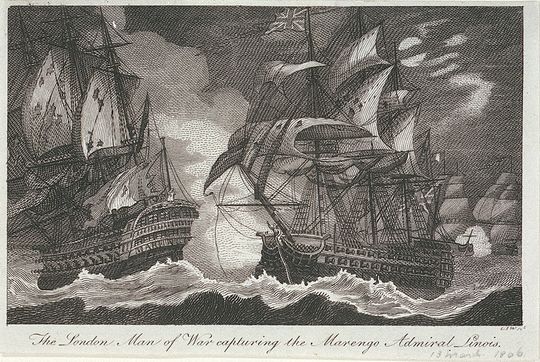HMS London (1766) on:
[Wikipedia]
[Google]
[Amazon]
HMS ''London'' was a 90-gun
 At the
At the
second-rate
In the rating system of the Royal Navy used to categorise sailing warships, a second-rate was a ship of the line which by the start of the 18th century mounted 90 to 98 guns on three gun decks; earlier 17th-century second rates had fewer guns ...
ship of the line
A ship of the line was a type of naval warship constructed during the Age of Sail from the 17th century to the mid-19th century. The ship of the line was designed for the naval tactics in the Age of Sail, naval tactic known as the line of battl ...
of the Royal Navy
The Royal Navy (RN) is the naval warfare force of the United Kingdom. It is a component of His Majesty's Naval Service, and its officers hold their commissions from the King of the United Kingdom, King. Although warships were used by Kingdom ...
, launched on 24 May 1766 at Chatham Dockyard
Chatham Dockyard was a Royal Navy Dockyard located on the River Medway in Kent. Established in Chatham, Kent, Chatham in the mid-16th century, the dockyard subsequently expanded into neighbouring Gillingham, Kent, Gillingham; at its most extens ...
.
''London'' was originally launched as a 90-gun ship, as was standard for second rates at the time, but was later increased to 98 guns when she had eight 12-pounders installed on her quarterdeck.
She was Sir Thomas Graves' flagship at the Battle of the Chesapeake
The Battle of the Chesapeake, also known as the Battle of the Virginia Capes or simply the Battle of the Capes, was a crucial naval battle in the American Revolutionary War that took place near the mouth of the Chesapeake Bay on 5 September 1 ...
in 1781. In the action of 18 October 1782, she was raked by and had to let her escape.
French Revolutionary Wars
She participated in theBattle of Groix
The Battle of Groix (, ) took place on 23 June 1795 off the island of Groix in the Bay of Biscay during the War of the First Coalition. It was fought between elements of the British Channel Fleet and the French Ponant Fleet, Atlantic Fleet, whi ...
in 1795.
Next, ''London'' participated in an abortive invasion of Ferrol. On 29 August 1800, in Vigo Bay, Admiral Sir Samuel Hood assembled a cutting-out party from the vessels under his command consisting of two boats each from , , , and , four boats from , as well as the boats from , ''London'' and ''Impetueux''. The party went in and after a 15-minute fight captured the French privateer ''Guêpe'', of Bordeaux and towed her out. She was of 300 tons burthen and had a flush deck. Pierced for 20 guns, she carried eighteen 9-pounders, and she and her crew of 161 men were under the command of Citizen Dupan. In the attack she lost 25 men killed, including Dupan, and 40 wounded. British casualties amounted to four killed, 23 wounded and one missing. In 1847 the Admiralty awarded the Naval General Service Medal with clasp "29 Aug. Boat Service 1800" to all surviving claimants from the action.
She was present at the Battle of Copenhagen in 1801, as part of Sir Hyde Parker's reserve fleet.
Napoleonic Wars
 At the
At the action of 13 March 1806
The action of 13 March 1806 was a naval engagement of the Napoleonic Wars, fought when a British and a French squadron met unexpectedly in the mid-Atlantic. Neither force was aware of the presence of the other prior to the encounter and were pa ...
, ''London'' captured the French ship of the line ''Marengo''. In 1807, she helped escort the Portuguese royal family in its flight from Portugal to Brazil.
Fate
''London'' was broken up in 1811.Notes
Citations
References
* Lavery, Brian (1983) ''The Ship of the Line - Volume 1: The development of the battlefleet 1650-1850.'' Conway Maritime Press. .External links
* Ships of the line of the Royal Navy London-class ships of the line 1766 ships {{UK-line-ship-stub